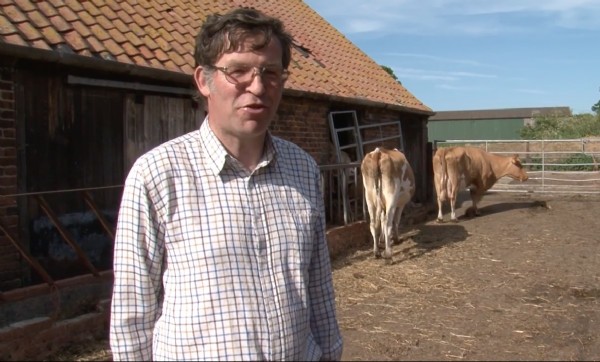

Tom and his family have been farming near Kings Lynn since the 1960s, having originally moved up from Hampshire. The farm is a mixed dairy and arable enterprise, based around a Guernsey milking herd, 200 acres of grassland and 500 acres of arable cropping including wheat, barley, oats, field beans and OSR.
The rotation is generally 4 to 5 years of arable cropping followed by 4 years of grass leys on land close to the parlour. Outlying areas tend to be used for arable production with short term 2 year leys containing legumes like vetch or red clover and ryegrass to improve soil fertility, build organic matter and reduce artificial inputs. Lucerne is now being grown on some of the lightest land. This crop requires very little nitrogen fertiliser.
Tom has relied on the Cholderton grazing and cutting ley as part of the grazing platform. This diverse mixture contains deep rooting species like cocksfoot and red clover along with bulk providing ryegrass and Timothy which suits the heavier land. He has also noticed that alsike clover, which is a short term perennial plant, performs well on his land.
The majority of the grass leys are established by ploughing and working down the ground to a fine, firm seed-bed. If moisture is present near the surface, a Horsch Pronto drill is used to sow the seed. He sets the coulters slightly above the ground, allowing the seed to drop onto the surface, followed by the Cambridge roll. This system stops the seed being drilled in regimented rows, reducing the openness of the sward, which might otherwise allow weeds to establish. If the soil conditions are dry the same drill will be set at a shallow depth of 0.5 cms, allowing the coulters to lightly break the surface, providing the newly sown seed with a light soil covering and access to moisture.
The grazing management of the leys is important, to ensure the maximum amount of production is achieved. The fields are strip grazed, with the front fence being moved twice a day and the back fence being moved at least weekly to stop the tender regrowth from earlier grazing being damaged.
The forage herb chicory is added to most of the mixtures at Burwood Hall, at a robust rate of 0.5 kg per acre. This provides a good coverage of chicory, which is very palatable and has anti worming properties. Tom believes the deep taproot breaks through any plough pans that may have built up over the years and is a great soil conditioner, as well as providing tremendous forage for livestock.
Tom is looking forward to seeing how the monster roots of the lucerne have conditioned and improved the soil, hopefully with a significant benefit for the following cereal crop.
Date Posted: 30th March 2017



